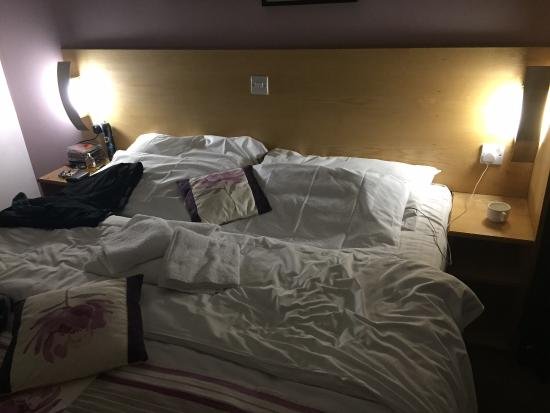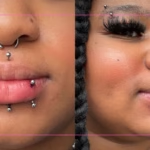When you step into a hotel room, one of the first things that catches your eye is the bed. It’s usually the centerpiece of the room—perfectly made, with crisp white sheets, fluffy pillows, and a sense of order and neatness that feels inviting. But among all the details, there’s one element that often sparks curiosity: the cloth strip laid across the foot of the bed. This piece of fabric is called a bed runner, and while many travelers assume it’s only there for decoration, the truth is that it serves multiple purposes—both functional and psychological.
In this article, we’ll break down 20 reasons why hotels use bed runners, and you’ll discover that it’s far more than just a stylish touch.
1. Aesthetic Enhancement – Adding a Touch of Style
A hotel’s first impression often comes from the room, and nothing makes a stronger visual impact than the bed. Since beds occupy a large portion of the room, hotels focus heavily on making them look appealing. White linens are the standard because they signal cleanliness and luxury, but a completely white bed can look too plain or clinical. This is where the bed runner steps in.
The runner acts like a fashion accessory for the bed, similar to how a scarf completes an outfit. It adds a pop of color, a hint of texture, or a patterned design that breaks the monotony of all-white bedding. This splash of style instantly upgrades the look of the room, giving it a more high-end and welcoming atmosphere.
Interior designers often coordinate the runner with the room’s curtains, upholstery, or carpeting, creating a cohesive theme. For example, in a seaside resort, the runner might feature ocean blues or shell patterns, while in a mountain lodge, it might showcase earthy tones and rustic textures. This subtle detail ensures the room feels thoughtfully designed rather than generic.
Hotels understand that guests notice these small touches subconsciously. A beautiful bed creates a sense of luxury and comfort before you even lie down, and that positive impression often influences how guests perceive the entire stay.
2. Branding and Identity – A Signature Look for Hotels
Hotels don’t just compete on comfort—they also compete on brand identity. A well-placed bed runner can help reinforce that identity. Many hotels use runners that match their brand colors or incorporate patterns that reflect their unique style. This way, even without logos, the fabric becomes a subtle form of branding.
For example, a luxury chain might use deep burgundy runners with golden embroidery, instantly signaling sophistication. A boutique hotel might go for quirky, colorful patterns that reflect creativity and uniqueness. By doing this, hotels make their rooms instantly recognizable and memorable.
Bed runners also serve as a way to differentiate categories of rooms. For instance, standard rooms might have a plain runner, while premium suites feature more elaborate designs. This adds to the sense of exclusivity and reinforces the value of an upgrade.
In essence, runners aren’t just cloth—they’re a part of the hotel’s visual storytelling. They help hotels leave a lasting impression on guests, which is crucial in the age of online reviews and social media, where a picture of the bed often ends up being shared worldwide.
3. Practical Protection – Shielding the Bedding
Beyond looks, bed runners have a very practical purpose: protecting the bedding. Guests often sit on the end of the bed while putting on shoes, unpacking luggage, or watching TV. Sometimes, they even place bags or items on the foot of the bed. Without a runner, the pristine white comforter could quickly get dirty.
The runner acts as a barrier between guests and the main blanket, absorbing dust, dirt, or accidental spills. Since runners are smaller and easier to wash than full-size comforters, this makes maintenance more efficient for hotels. Rather than laundering large, bulky duvets after every guest (which is time-consuming and costly), hotels can simply wash or replace the runner more frequently.
This small addition helps keep the rest of the bedding in better condition for longer, saving hotels money on laundry and extending the life of their linens. It’s a smart combination of practicality and cost-effectiveness, cleverly hidden beneath the appearance of luxury.
4. Hygiene Considerations – A Psychological Reassurance
Guests place a high value on cleanliness when staying in hotels, and the bed is the most sensitive part of that equation. By adding a runner, hotels provide not just physical protection but also psychological reassurance.
For example, if a guest needs to place a suitcase temporarily on the bed, they’re more likely to use the runner instead of the white comforter. This makes them feel less guilty about potentially dirtying the bedding. Similarly, people sometimes sit on the runner area while leaving the main section untouched, which reassures them that the part they’ll sleep on remains fresh and clean.
Even though the runner itself isn’t meant to be a blanket or functional cover, its presence gives guests peace of mind, which enhances their sense of comfort during the stay.
5. Cost Efficiency for Hotels – Smart Laundry Management
Running a hotel is as much about aesthetics as it is about efficiency. Washing and replacing large comforters and duvets after every stay would be both expensive and labor-intensive. Bed runners solve part of this challenge.
Since runners are relatively small, hotels can wash them frequently at a fraction of the cost of washing bulky bedding. This saves water, electricity, detergent, and staff time. Over hundreds or thousands of guests per year, the savings add up significantly.
Moreover, since runners absorb the majority of minor wear and tear, they prolong the lifespan of more expensive bedding items. In short, they’re an economical solution disguised as a decorative feature, which is why nearly every hotel adopts them.
6. Seasonal and Festive Customization – Setting the Mood
Hotels constantly adapt to seasons, holidays, and special occasions. Bed runners make this process easy. Instead of overhauling the entire room décor, hotels can simply swap out the runner to create a new theme.
For instance, during Christmas, a hotel might use runners in red and green with festive designs. In summer, they might switch to bright, tropical patterns to match the vacation vibe. This allows hotels to refresh their rooms with minimal cost and effort, while guests feel they’re experiencing something special and timely.
Festive runners also help hotels showcase attention to detail. Guests notice when hotels go the extra mile to align with the season or holiday, and it often leaves a positive impression that boosts guest satisfaction and loyalty.
7. Comfort and Warmth – Psychological Perception of Coziness
Even though bed runners are not blankets, they contribute to the overall sense of warmth and comfort. When guests walk into a room and see a runner across the bed, it makes the setup look more inviting and cozy.
Humans associate layered bedding with luxury and comfort. The runner gives the impression that the bed has been dressed with extra care, which makes it feel more premium. This psychological perception matters a great deal in hospitality, where creating an emotional connection is key to customer satisfaction.
8. Photography and Marketing – Instagram-Ready Rooms
In the digital age, appearance is everything. Hotels know that guests often take photos of their rooms and share them online. A plain white bed may look clean, but it doesn’t always photograph well. Add a colorful or patterned runner, and suddenly, the bed looks like it belongs in a magazine spread.
This boosts the visual appeal for marketing—both in official hotel advertisements and in user-generated content like Instagram posts. The bed runner, in this way, becomes a silent marketing tool that helps hotels look more attractive online, which in turn attracts more bookings.
9. Room Differentiation – Identifying Room Levels Easily
Bed runners can also act as a subtle way to differentiate between room categories. Standard rooms may have a simple runner, while premium suites boast fancier, embroidered versions. This not only adds exclusivity but also gives guests a tangible sense of upgrade when they book higher categories.
For staff, this differentiation can also help with quick room recognition. Housekeeping teams can identify room levels at a glance simply by looking at the runner design, making operations smoother.
10. Tradition and Expectation – Part of Hotel Culture
Over time, bed runners have become a symbol of hotel tradition. Guests expect to see them, even if they don’t consciously know why. Hotels, in turn, continue to use them because they’ve become part of the visual culture of hospitality.
The presence of a runner signals professionalism and consistency. Guests feel reassured when they see it because it subconsciously tells them that the hotel follows industry norms and cares about presentation.
11. A Practical Spot for Extra Belongings
When you’re in a hotel room, especially after traveling, you often have smaller belongings like scarves, shawls, books, or even shopping bags that you don’t immediately put away. The cloth across the bed serves as a handy spot to temporarily place these items without cluttering the main white bedding. Many guests avoid placing personal items directly on white sheets since they fear it might leave marks or wrinkles. The runner works as a “buffer zone,” where such belongings can rest safely. For example, a guest might keep their handbag or travel wallet on the runner when they’re getting ready in the morning, knowing it won’t dirty the bed itself. This makes it both functional and reassuring for those who care about cleanliness. Hotels include this element so guests feel comfortable handling their day-to-day belongings without anxiety. Over time, travelers notice they tend to use the runner more often than expected. This little detail adds convenience while quietly maintaining the hotel’s promise of spotless bedding.
12. Helps Housekeeping Spot Wrinkles and Creases
One detail that most guests overlook is that hotel staff rely on the cloth to spot imperfections. A bed runner isn’t just decoration—it helps highlight wrinkles or unevenly spread sheets during inspection. When the cloth is placed neatly and straight across, it creates a contrast that makes it easier to notice if the white bedding below isn’t perfectly aligned. Housekeeping teams often use it as a visual guide to check the symmetry of the bed. Since hotel beds are expected to look crisp and photo-worthy, the runner plays a quiet role in ensuring perfection. If there’s a small fold, dust mark, or misaligned edge, the difference becomes visible against the patterned runner. This saves time for the staff and ensures guests always walk into a room where the bed looks flawless. In the hospitality industry, even small things like this become powerful tools of presentation. So, while guests may think it’s just there for beauty, it’s actually part of the inspection process.
13. A Way to Add Color Without Overdoing It
Hotel rooms are often designed in neutral or soft tones to create a sense of calm and universality. However, neutral colors can sometimes feel too plain. This is where the bed runner makes a difference. Instead of overwhelming the room with bold patterns or heavy-colored blankets, the cloth adds just the right pop of color. For example, a beige and cream room might feel flat, but a golden runner instantly makes the bed more inviting. Designers prefer using bed runners because they can be swapped seasonally or whenever the hotel renovates its theme, without having to change all the linens or furniture. It’s a cost-effective way to update aesthetics while maintaining sophistication. Guests subconsciously register these colors, and it affects how “warm” or “modern” they perceive the hotel. This design trick balances elegance with practicality. So, that little strip of cloth across the bed is a clever way to blend creativity with efficiency.
14. Keeps Bedding Layers in Place
Anyone who has ever tossed and turned at night knows how easily blankets and sheets can slide around. In hotels, where presentation is everything, loose bedding can look messy in the morning. The runner plays a small but effective role in holding the bedding layers together. By laying across the bed, it adds weight that helps secure the sheets and duvet in position. Even if a guest kicks or moves around, the layers don’t shift as much. This ensures the bed looks tidier after use and is easier for housekeeping staff to reset. It might not completely prevent movement, but it certainly minimizes disorder. Guests don’t usually notice this, but hotel managers know that fewer disrupted layers mean quicker cleaning turnaround. Over hundreds of rooms, this small detail saves both time and effort. This is another example of how something that looks purely decorative also has a functional advantage.
15. Symbol of Luxury and Attention to Detail
In the world of hotels, perception matters just as much as actual comfort. A neatly folded bed with a runner instantly communicates sophistication and care. Even budget-friendly hotels sometimes adopt runners to create an illusion of luxury. Guests often associate these details with higher-class hospitality, even if the room itself is modest. It’s part of the psychology of presentation: a room with a bed runner simply feels “complete.” Without it, the bed might look unfinished or plain. This sense of luxury can elevate the entire guest experience, making people more likely to rate the stay positively. For hoteliers, the cost of adding a runner is small compared to the impact it has on guest perception. So, that little cloth ends up carrying a lot of symbolic weight—it’s a signal that the hotel cares about the details that make a stay memorable.
16. Provides a Place for Towels and Robes
Hotels often place neatly folded towels or robes on the bed for guests when they first arrive. But leaving these items directly on the crisp white sheets could create creases or transfer small fibers. The bed runner solves this problem by providing a clean, sturdy base. Guests can find their towels presented attractively on the runner, which also protects the bedding from any possible lint. Similarly, some hotels place decorative folded shapes—like towel swans or robes—on the runner to enhance presentation. This thoughtful touch enhances the sense of arrival and makes the bed feel welcoming. Guests often take photos of such arrangements, which serve as subtle marketing for the hotel when shared online. Thus, the runner is more than cloth—it’s part of how hotels craft Instagram-worthy experiences.
17. Easier to Wash Than Full Bedding
Imagine a guest places their suitcase, shoes, or even food on the bed. Cleaning a full duvet cover takes significant effort, time, and laundry costs. But cleaning a small runner is far easier. Most hotels design their housekeeping operations around efficiency, and runners are lightweight, easy to wash, and quick to dry compared to bedding. This practicality means that even if something gets dirty, the hotel can clean or replace the runner without disrupting operations. Over time, this saves money while still ensuring rooms look neat and hygienic. Many hotels even keep multiple runners ready, so a room can be refreshed in minutes. Guests rarely notice this cost-effective strategy, but it’s one reason hotels can maintain such high standards consistently. Behind the scenes, that little strip of fabric is a powerful tool in maintaining both cleanliness and budgets.
18. Seasonal and Thematic Customization
Hotels love to surprise guests with seasonal touches, whether it’s for holidays, festivals, or events. Instead of redesigning entire rooms, they often swap out runners with themed versions. For example, during Christmas, a hotel might use runners in red and gold, while for summer, they might switch to bright, beach-inspired colors. This instantly updates the vibe of the room, making it feel more festive and in tune with the season. Guests appreciate these thoughtful touches, as they feel the hotel is going the extra mile to enhance their experience. Runners allow flexibility without large expenses, making them a clever design hack. It’s one of the most cost-effective ways for hotels to refresh their rooms regularly while keeping guests delighted. What seems like just a cloth is, in fact, a key tool in creating experiences that feel tailored and memorable.
19. Reduces Signs of Wear and Tear
Hotel beds see constant use, and over time, certain areas can show wear faster than others. The foot of the bed, in particular, experiences more contact from luggage, shoes, or even people sitting. The runner helps protect this zone from becoming visibly worn or faded compared to the rest of the bedding. By covering the most high-traffic section, hotels extend the life of their linens and keep the bed looking fresher for longer. Without runners, hotels would likely have to replace bedding much more often. This small addition becomes an economical way to manage wear and tear while keeping the room polished. Guests, in turn, enjoy a bed that looks newer and well-maintained, which improves their perception of the hotel’s quality. So, while guests may not notice it directly, the runner is quietly extending the life of hotel bedding every single day.
20. Creates a Psychological Sense of Order
Lastly, one of the most overlooked purposes of the bed runner is psychological. Human beings naturally notice symmetry, order, and alignment. A room with a clean, straight runner across the bed creates a sense of balance that is calming to the mind. Even if guests don’t consciously recognize it, they feel the room is tidier and more inviting. Without the runner, the bed might look like it’s missing something, even if the linens are spotless. Hotels rely heavily on first impressions, and the runner acts like the finishing brushstroke in a painting. It tells the guest: this room is complete, cared for, and ready for you. In hospitality, creating this subtle sense of order goes a long way in ensuring satisfaction. Guests leave with the impression that the hotel was organized, professional, and thoughtful—simply because of one small piece of cloth placed with intention.



